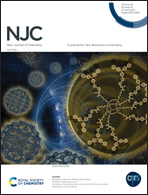A DFT-D study on the reaction mechanism of selective catalytic reduction of NO by NH3 over the Fe2O3/Ni(111) surface†
Abstract
The gas adsorption properties and NH3-SCR reaction mechanism over the Fe2O3/Ni(111) surface were investigated by a DFT-D study. The results show that the Fe2O3 cluster has more excellent gas adsorption performance than the Ni carrier. Single gas adsorption products are coordinated ammonia, nitroso, and adsorption oxygen, respectively. The presence of O2 promotes bimolecular adsorption. Three NH3-SCR reaction routes are revealed and mainly follow the Eley–Rideal mechanism. The reaction of NH3 and NO involves five steps: (1) NH3* dehydrogenation, (2) NH2NO* generation, (3) NHNO* generation, (4) NHNO* dissociation, and (5) H2O generation. NHNO* dissociation into N2 releases lots of energy. The reaction of O2 and NO eventually forms NO2, and is an energetically favorable process. Reaction of NO2 with NH3 involves three steps: (1) NH2NO2 generation, (2) NHNO2 generation, and (3) NHNO2 dissociation. NHNO2* decomposition and H2O* desorption as the rate-determining steps control the whole reaction rate. In addition, the reason for the high NOx conversion of “fast-SCR” is that NO2 reacts more easily with NH2 to form a nitrogen intermediate compared to NO.



 Please wait while we load your content...
Please wait while we load your content...